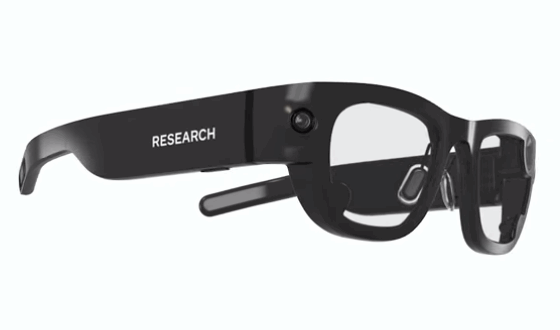SOCIAL
New Details Emerge of Meta’s Ten-Year Growth Plan for AR Wearables and the Metaverse

The metaverse is the future of Meta, and Mark Zuckerberg’s own legacy, but in order to make the fully immersive, fully interactive metaverse a reality, Meta will need to usher in a whole new age of tech adoption, involving high take-up of its VR headsets, as well as it’s coming AR glasses product.
Which, today, we got a whole new range of details on, via a new report from The Verge, which, based on information from Meta insiders, has outlined the key details of Meta’s AR glasses roll-out plan.
Before you get too excited – they won’t be here till at least next year, if Meta’s able to meet that timeline, so there’s quite a way to go as yet.
As reported by The Verge, Meta’s currently developing its initial AR glasses product, called ‘Project Nazare’, which would work independently from a mobile phone, and utilize wrist controls to navigate the various functions. Meta’s also developing a lower cost variation called ‘Hypernova’ which would be tethered to your mobile device.
As per The Verge:
“Perhaps the most futuristic aspect of the first versions of both Nazare and Hypernova is a wrist device that Meta plans to bundle with the glasses for controlling them, hypothetically, with the wearer’s mind – something that will likely be the company’s next big privacy hurdle. The wristband uses differential electromyography, or EMG, to measure electrical pulses in the arm’s neurons, essentially creating the effect of a phantom limb the wearer can use to interact with the glasses.”
Meta’s been working on EMG tech for some time, so it’s not a major surprise to see them looking to utilize such for controlling its AR peripherals.
But even so, that’s a big functional leap, which could usher in a whole new age of habitual interaction with tech – and really, that element will largely determine the ultimate success or failure of the project.
Which, in some ways, is what Meta is going for, with employees describing its AR glasses as Meta’s ‘iPhone moment’, with Zuckerberg staking his reputation on the success of this next phase, and how it will transform the way that we interact with the world around us.
It’s interesting to consider the emphasis that the company is putting on AR wearables, especially given that the majority of its metaverse focus thus far has seemingly highlighted VR worlds, accessible via its standalone Quest headsets.
AR will also play a key role within this, by connecting people into its digital realms in a broader range of ways, while also providing in-view prompts and tools to facilitate an expanded range of interactions than we’re currently accustomed to via AR options.
Most of what we can currently experience in AR, we see through our phone screens, with digital masks that can alter how we look, or digital characters that can be superimposed over the real world.

But Meta’s vision goes further than this:
“A marquee feature will be the ability to communicate and interact with holograms of other people through the glasses, which Zuckerberg believes will, over time, provide people with a more immersive, compelling experience than the video calling that exists today.”
That would indeed be an amazing experience, if Meta can make it happen.
Thus far, we’ve seen few working examples of such in action, with Meta’s ‘Project Aria’ showreel the only true representation of its progress on AR glasses.
But according to insiders, its plans are well advanced, with some describing its more recent demonstrations of the tech as ‘the most impressive they’ve ever experienced’.
It’ll still take a lot of work – difficulties with chip suppliers and other costs will likely increase the retail price of the glasses, which will make it harder for Meta to usher in broad adoption, at least in its early stages. But Meta’s road map, at least right now, will likely see a first version of its AR glasses launched in 2024, with a lighter, more advanced design slated for 2026, followed by a third variation in 2028.
That probably works more with Meta’s metaverse timeline, which it’s repeatedly noted will take many years, even a decade, to come to fruition.
Meta’s plan is to be selling ‘tens of millions’ of AR-enabled smart glasses towards the end of this decade, which is really when it expects to see most of its metaverse bets paying off.
Which is a big, long-term bet, and will likely see Meta go through various stages of market turmoil, as Facebook adoption continues to slow, and Meta continues to pump more and more money into its next-stage projects.
Will that put too much pressure on the company? Will it be able to manage the various privacy concerns and health issues associated with expanded metaverse use?
And ultimately, will Meta really be able to build this expanded, theoretical metaverse, that will cater to all sorts of digital interactions, and enable people to engage in whole new worlds of their own making?
There’s a lot that needs to go right, but Meta has a plan. And it could well be the future, even if we don’t know it yet.
Source link
SOCIAL
12 Proven Methods to Make Money Blogging in 2024

 This is a contributed article.
This is a contributed article.
The world of blogging continues to thrive in 2024, offering a compelling avenue for creative minds to share their knowledge, build an audience, and even turn their passion into profit. Whether you’re a seasoned blogger or just starting, there are numerous effective strategies to monetize your blog and achieve financial success. Here, we delve into 12 proven methods to make money blogging in 2024:
1. Embrace Niche Expertise:
Standing out in the vast blogosphere requires focus. Carving a niche allows you to cater to a specific audience with targeted content. This not only builds a loyal following but also positions you as an authority in your chosen field. Whether it’s gardening techniques, travel hacking tips, or the intricacies of cryptocurrency, delve deep into a subject you’re passionate and knowledgeable about. Targeted audiences are more receptive to monetization efforts, making them ideal for success.
2. Content is King (and Queen):
High-quality content remains the cornerstone of any successful blog. In 2024, readers crave informative, engaging, and well-written content that solves their problems, answers their questions, or entertains them. Invest time in crafting valuable blog posts, articles, or videos that resonate with your target audience.
- Focus on evergreen content: Create content that remains relevant for a long time, attracting consistent traffic and boosting your earning potential.
- Incorporate multimedia: Spice up your content with captivating images, infographics, or even videos to enhance reader engagement and improve SEO.
- Maintain consistency: Develop a regular publishing schedule to build anticipation and keep your audience coming back for more.
3. The Power of SEO:
Search Engine Optimization (SEO) ensures your blog ranks high in search engine results for relevant keywords. This increases organic traffic, the lifeblood of any monetization strategy.
- Keyword research: Use keyword research tools to identify terms your target audience searches for. Strategically incorporate these keywords into your content naturally.
- Technical SEO: Optimize your blog’s loading speed, mobile responsiveness, and overall technical aspects to improve search engine ranking.
- Backlink building: Encourage other websites to link back to your content, boosting your blog’s authority in the eyes of search engines.
4. Monetization Magic: Affiliate Marketing
Affiliate marketing allows you to earn commissions by promoting other companies’ products or services. When a reader clicks on your affiliate link and makes a purchase, you get a commission.
- Choose relevant affiliates: Promote products or services that align with your niche and resonate with your audience.
- Transparency is key: Disclose your affiliate relationships clearly to your readers and build trust.
- Integrate strategically: Don’t just bombard readers with links. Weave affiliate promotions naturally into your content, highlighting the value proposition.
5. Display Advertising: A Classic Approach
Display advertising involves placing banner ads, text ads, or other visual elements on your blog. When a reader clicks on an ad, you earn revenue.
- Choose reputable ad networks: Partner with established ad networks that offer competitive rates and relevant ads for your audience.
- Strategic ad placement: Place ads thoughtfully, avoiding an overwhelming experience for readers.
- Track your performance: Monitor ad clicks and conversions to measure the effectiveness of your ad placements and optimize for better results.
6. Offer Premium Content:
Providing exclusive, in-depth content behind a paywall can generate additional income. This could be premium blog posts, ebooks, online courses, or webinars.
- Deliver exceptional value: Ensure your premium content offers significant value that justifies the price tag.
- Multiple pricing options: Consider offering tiered subscription plans to cater to different audience needs and budgets.
- Promote effectively: Highlight the benefits of your premium content and encourage readers to subscribe.
7. Coaching and Consulting:
Leverage your expertise by offering coaching or consulting services related to your niche. Readers who find your content valuable may be interested in personalized guidance.
- Position yourself as an expert: Showcase your qualifications, experience, and client testimonials to build trust and establish your credibility.
- Offer free consultations: Provide a limited free consultation to potential clients, allowing them to experience your expertise firsthand.
- Develop clear packages: Outline different coaching or consulting packages with varying time commitments and pricing structures.
8. The Power of Community: Online Events and Webinars
Host online events or webinars related to your niche. These events offer valuable content while also providing an opportunity to promote other monetization avenues.
- Interactive and engaging: Structure your online events to be interactive with polls, Q&A sessions, or live chats. Click here to learn more about image marketing with Q&A sessions and live chats.
9. Embrace the Power of Email Marketing:
Building an email list allows you to foster stronger relationships with your audience and promote your content and offerings directly.
- Offer valuable incentives: Encourage readers to subscribe by offering exclusive content, discounts, or early access to new products.
- Segmentation is key: Segment your email list based on reader interests to send targeted campaigns that resonate more effectively.
- Regular communication: Maintain consistent communication with your subscribers through engaging newsletters or updates.
10. Sell Your Own Products:
Take your expertise to the next level by creating and selling your own products. This could be physical merchandise, digital downloads, or even printables related to your niche.
- Identify audience needs: Develop products that address the specific needs and desires of your target audience.
- High-quality offerings: Invest in creating high-quality products that offer exceptional value and user experience.
- Utilize multiple platforms: Sell your products through your blog, online marketplaces, or even social media platforms.
11. Sponsorships and Brand Collaborations:
Partner with brands or businesses relevant to your niche for sponsored content or collaborations. This can be a lucrative way to leverage your audience and generate income.
- Maintain editorial control: While working with sponsors, ensure you retain editorial control to maintain your blog’s authenticity and audience trust.
- Disclosures are essential: Clearly disclose sponsored content to readers, upholding transparency and ethical practices.
- Align with your niche: Partner with brands that complement your content and resonate with your audience.
12. Freelancing and Paid Writing Opportunities:
Your blog can serve as a springboard for freelance writing opportunities. Showcase your writing skills and expertise through your blog content, attracting potential clients.
- Target relevant publications: Identify online publications, websites, or magazines related to your niche and pitch your writing services.
- High-quality samples: Include high-quality blog posts from your site as writing samples when pitching to potential clients.
- Develop strong writing skills: Continuously hone your writing skills and stay updated on current trends in your niche to deliver exceptional work.
Conclusion:
Building a successful blog that generates income requires dedication, strategic planning, and high-quality content. In today’s digital age, there are numerous opportunities to make money online through blogging. By utilizing a combination of methods such as affiliate marketing, sponsored content, and selling digital products or services, you can leverage your blog’s potential and achieve financial success.
Remember, consistency in posting, engaging with your audience, and staying adaptable to trends are key to thriving in the ever-evolving blogosphere. Embrace new strategies, refine your approaches, and always keep your readers at the forefront of your content creation journey. With dedication and the right approach, your blog has the potential to become a valuable source of income and a platform for sharing your knowledge and passion with the world, making money online while doing what you love.
Image Credit: DepositPhotos
SOCIAL
Snapchat Explores New Messaging Retention Feature: A Game-Changer or Risky Move?

In a recent announcement, Snapchat revealed a groundbreaking update that challenges its traditional design ethos. The platform is experimenting with an option that allows users to defy the 24-hour auto-delete rule, a feature synonymous with Snapchat’s ephemeral messaging model.
The proposed change aims to introduce a “Never delete” option in messaging retention settings, aligning Snapchat more closely with conventional messaging apps. While this move may blur Snapchat’s distinctive selling point, Snap appears convinced of its necessity.
According to Snap, the decision stems from user feedback and a commitment to innovation based on user needs. The company aims to provide greater flexibility and control over conversations, catering to the preferences of its community.
Currently undergoing trials in select markets, the new feature empowers users to adjust retention settings on a conversation-by-conversation basis. Flexibility remains paramount, with participants able to modify settings within chats and receive in-chat notifications to ensure transparency.
Snapchat underscores that the default auto-delete feature will persist, reinforcing its design philosophy centered on ephemerality. However, with the app gaining traction as a primary messaging platform, the option offers users a means to preserve longer chat histories.
The update marks a pivotal moment for Snapchat, renowned for its disappearing message premise, especially popular among younger demographics. Retaining this focus has been pivotal to Snapchat’s identity, but the shift suggests a broader strategy aimed at diversifying its user base.
This strategy may appeal particularly to older demographics, potentially extending Snapchat’s relevance as users age. By emulating features of conventional messaging platforms, Snapchat seeks to enhance its appeal and broaden its reach.
Yet, the introduction of message retention poses questions about Snapchat’s uniqueness. While addressing user demands, the risk of diluting Snapchat’s distinctiveness looms large.
As Snapchat ventures into uncharted territory, the outcome of this experiment remains uncertain. Will message retention propel Snapchat to new heights, or will it compromise the platform’s uniqueness?
Only time will tell.
SOCIAL
Catering to specific audience boosts your business, says accountant turned coach

While it is tempting to try to appeal to a broad audience, the founder of alcohol-free coaching service Just the Tonic, Sandra Parker, believes the best thing you can do for your business is focus on your niche. Here’s how she did just that.
When running a business, reaching out to as many clients as possible can be tempting. But it also risks making your marketing “too generic,” warns Sandra Parker, the founder of Just The Tonic Coaching.
“From the very start of my business, I knew exactly who I could help and who I couldn’t,” Parker told My Biggest Lessons.
Parker struggled with alcohol dependence as a young professional. Today, her business targets high-achieving individuals who face challenges similar to those she had early in her career.
“I understand their frustrations, I understand their fears, and I understand their coping mechanisms and the stories they’re telling themselves,” Parker said. “Because of that, I’m able to market very effectively, to speak in a language that they understand, and am able to reach them.”Â
“I believe that it’s really important that you know exactly who your customer or your client is, and you target them, and you resist the temptation to make your marketing too generic to try and reach everyone,” she explained.
“If you speak specifically to your target clients, you will reach them, and I believe that’s the way that you’re going to be more successful.
Watch the video for more of Sandra Parker’s biggest lessons.
-

 WORDPRESS7 days ago
WORDPRESS7 days agoThe Ultimate WordPress Toolkit for Pros (59+ Must-Have Tools)
-

 AI2 days ago
AI2 days agoHow AI is Transforming SEO and What Website Owners Need to Know
-

 WORDPRESS6 days ago
WORDPRESS6 days agoHostinger Review: Website Creation Made Easy
-

 SEARCHENGINES6 days ago
SEARCHENGINES6 days agoGoogle Ranking Movement, Sitelinks Search Box Going Away, Gen-AI In Bing & Google, Ad News & More
-
SEARCHENGINES7 days ago
Daily Search Forum Recap: October 25, 2024
-

 SEARCHENGINES5 days ago
SEARCHENGINES5 days agoGoogle Search Ranking Volatility October 26th & 27th & 23rd & 24th
-

 WORDPRESS6 days ago
WORDPRESS6 days ago5 Most Profitable Online Businesses You Can Start Today for Free!
-

 WORDPRESS5 days ago
WORDPRESS5 days agoAutomattic demanded web host pay $32M annually for using WordPress trademark
















You must be logged in to post a comment Login